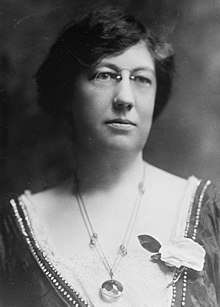Anna Pendleton Schenck
Anna Pendleton Schenck (January 8, 1874 - April 29, 1915) was an architect.[1][2] She was the business partner of Marcia Mead (1879-1967) and they established the first female architectural firm in New York City in 1914.[3]
Anna Pendleton Schenck | |
|---|---|
 | |
| Born | January 8, 1874 Brooklyn, NY |
| Died | April 29, 1915 (aged 41) Manhattan, New York |
| Occupation | Architect |
Biography
Schenck was born on January 8, 1874 in Brooklyn, New York to Noah Hunt Schenck and Ann Pierce Pendleton.[1]
Schenck attended Columbia University and was one of the first female graduates.[1] In Paris she studied under Aubertin.[1][3]
In March 1914, Schenck and Mead established an architectural firm.[1] They completed some country houses in New York and New Jersey, a neighborhood center for children, and the Ellen Memorial Homes in Washington, DC.[3][4] They were awarded first honor for their concept of a neighborhood center for the Bronx by the Chicago City Club in March 1915.[1][5]
Schenck died of pneumonia on April 29, 1915 at New York Hospital.[1][5] Mead retained the name Schenck and Mead for several years after Schenck's death.[5]
References
- "Miss Anna P. Schenck, Architect, Dies" (PDF). The New York Times. April 30, 1915. Retrieved January 20, 2014.
- "Girl Architects Organize A Firm. First of Its Kind, It's Expected to Show That Women Need Only Opportunity" (PDF). The New York Times. March 8, 1914. Retrieved January 20, 2014.
- Sarah Allaback (2008). "Marcia Mead (1879-1967)". The First American Women Architects. ISBN 9780252033216.
- "Architectural drawings for apartment houses ("The Ellen Wilson Memorial Homes"), Washington, D.C." The Library of Congress. Retrieved October 19, 2018.
- Coburn, Leslie (April 30, 2013). "Considering the People on the Back Streets: Urban Planning at the City Club of Chicago". In Van Zantzen, David (ed.). Drawing the Future: Chicago Architecture on the International Stage, 1900–1925. Evanston, IL: Northwestern University Press. p. 102. ISBN 9780810128989. OCLC 811137317. Retrieved March 2, 2020 – via Google Books.